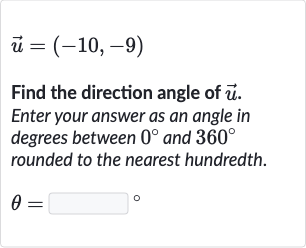Full solution
Q. Find the direction angle of . Enter your answer as an angle in degrees between and rounded to the nearest hundredth.
- Calculate Ratio Arctangent: To find the direction angle of the vector , we need to calculate the angle that this vector makes with the positive x-axis. The direction angle can be found using the arctangent function (also known as the inverse tangent or atan), which gives us the angle whose tangent is the ratio of the y-coordinate to the x-coordinate of the vector.
- Convert Radians to Degrees: First, we calculate the arctangent of the ratio of the y-coordinate to the x-coordinate of the vector . Since , the ratio is . Using a calculator, we find that gives us an angle in radians.
- Adjust for Quadrant: We convert the angle from radians to degrees because the question asks for the answer in degrees. To convert radians to degrees, we multiply by .
- Perform Calculation: The calculated angle will give us the angle relative to the positive x-axis, but since both the x and y coordinates of are negative, lies in the third quadrant. The arctangent function will give us an angle in the first quadrant, so we need to add ° to get the correct direction angle in the third quadrant.
- Add Degrees: Performing the calculation, we have . Using a calculator, we find that .
- Round to Nearest Hundredth: Adding ° to .°, we get . This is the direction angle of vector in the third quadrant, measured counterclockwise from the positive x-axis.
- Round to Nearest Hundredth: Adding ° to .°, we get . This is the direction angle of vector in the third quadrant, measured counterclockwise from the positive x-axis.We round the direction angle to the nearest hundredth as the question asks. Therefore, the direction angle of vector is approximately .°.
More problems from Inverses of sin, cos, and tan: degrees
QuestionGet tutor help
QuestionGet tutor help
QuestionGet tutor help
QuestionGet tutor help
QuestionGet tutor help
QuestionGet tutor help
Question
. Find the value of in degrees.Write your answer in simplified, rationalized form. Do not round.____
Get tutor helpQuestionGet tutor help

